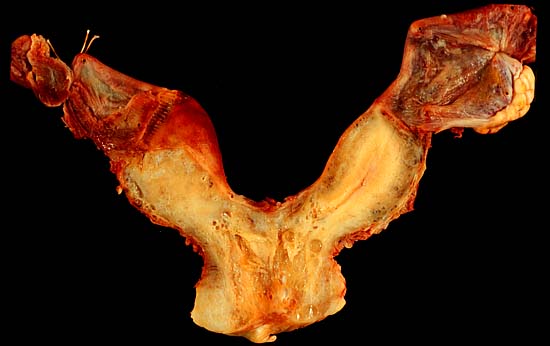- Bicornuate uterus
Infobox_Disease
Name = PAGENAME

Caption = A human bicornuate uterus
DiseasesDB =
ICD10 =
ICD9 = ICD9|752.3
ICDO =
OMIM =
MedlinePlus =
eMedicineSubj =
eMedicineTopic =
MeshID =
A bicornuate uterus, commonly referred to as a "heart-shaped" uterus, is a type of anuterine malformation where two "horns" form at the upper part of the uterus.Pathophysiology
A bicornuate uterus is formed during
embryogenesis . The fusion process of the upper part of theMüllerian ducts is altered. As a result the caudal part of the uterus is normal while the cranial part is bifurcated.Classification
There are many degrees of a bicornuate uterus.There is a continuous range of the degree and location of the
Müllerian ducts fusion and existence of a septum rather than a fixed number of types corresponding to strict medical definitions.Two processes that occur during the embryonic development of the Müllerian ducts, fusion and reabsorption, can be affected to different degrees. [cite journal |author=Acién P, Acién M, Sánchez-Ferrer ML |title=Müllerian anomalies "without a classification": from the didelphys-unicollis uterus to the bicervical uterus with or without septate vagina |journal=Fertil. Steril. |volume= |issue= |pages= |year=2008 |pmid=18367185 |doi=10.1016/j.fertnstert.2008.01.079 |url=] The degree can determine the likeliness of a pregnancy reaching full-term.Epidemiology
The occurrence of all types of müllerian duct abnormalities in women is estimated around 0.4%. [cite journal |author=Byrne J, Nussbaum-Blask A, Taylor WS, "et al" |title=Prevalence of Müllerian duct anomalies detected at ultrasound |journal=Am. J. Med. Genet. |volume=94 |issue=1 |pages=9–12 |year=2000 |pmid=10982475 |doi=10.1002/1096-8628(20000904)94:1<9::AID-AJMG3>3.0.CO;2-H |url=] A bicornuate uterus is estimated to occur in 0.1-0.5% of women in the U.S.It is possible that this is an underestimate since saddle abnormalities often go undetected.
Effect on reproduction
Pregnancies in a bicornuate uterus are usually considered high-risk and require extra monitoring because of association with poor reproduction potential.A bicornuate uterus is associated with increased adverse reproductive outcomes like:
1. Recurrent pregnancy loss. The reproductive potential of a bicornuate uterus is usually measured by live birth rate (also called fetal survival rate).This rate is estimated around 63% for a bicornuate uterus. [cite journal |author=Rackow BW, Arici A |title=Reproductive performance of women with müllerian anomalies |journal=Curr. Opin. Obstet. Gynecol. |volume=19 |issue=3 |pages=229–37 |year=2007 |pmid=17495638 |doi=10.1097/GCO.0b013e32814b0649 |url=]
2. Preterm delivery.With a 15 -25% rate of preterm delivery. The reason that a pregnancy may not reach full-term in a bicornuate uterus often happens when the baby begins to grow in either of the protrusions at the top.A short cervical length seems to be a good predictor of preterm delivery in women with a bicurnuate uterus. [cite journal |author=Airoldi J, Berghella V, Sehdev H, Ludmir J |title=Transvaginal ultrasonography of the cervix to predict preterm birth in women with uterine anomalies |journal=Obstet Gynecol |volume=106 |issue=3 |pages=553–6 |year=2005 |pmid=16135586 |doi=10.1097/01.AOG.0000173987.59595.e2 |url=]
3. Malpresentation (
breech birth or transverse presentation).A breech presentation occurs in 40-50% pregnancies with a partial bicornuate uterus and not at all (0%) in complete bicornuate uterus. [cite journal |author=Heinonen PK, Saarikoski S, Pystynen P |title=Reproductive performance of women with uterine anomalies. An evaluation of 182 cases |journal=Acta Obstet Gynecol Scand |volume=61 |issue=2 |pages=157–62 |year=1982 |pmid=7113692 |doi= |url=]
Previously, a bicornuate uterus was thought to be associated with infertility [cite journal |author=Shuiqing M, Xuming B, Jinghe L |title=Pregnancy and its outcome in women with malformed uterus |journal=Chin. Med. Sci. J. |volume=17 |issue=4 |pages=242–5 |year=2002 |pmid=12901513 |doi= |url=] , but recent studies have not confirmed such an association [cite journal |author=Proctor JA, Haney AF |title=Recurrent first trimester pregnancy loss is associated with uterine septum but not with bicornuate uterus |journal=Fertil. Steril. |volume=80 |issue=5 |pages=1212–5 |year=2003 |pmid=14607577 |doi= |url=http://linkinghub.elsevier.com/retrieve/pii/S0015028203011695] .Diagnosis
It is very difficult, though sometimes possible, to diagnose a bicornuate uterus using an ultrasound.As a result, a bicornuate uterus often goes undetected until delivery. In a c-section (usually done due to malpresentation) the irregular shape of the uterus can be noticed.Imaging detection methods include:
hysterosalpingography andhysteroscopy .MRI is emerging as an accurate detection method for bicornuate uterus as well as other Müllerian duct abnormalities. [cite journal |author=Marten K, Vosshenrich R, Funke M, Obenauer S, Baum F, Grabbe E |title=MRI in the evaluation of müllerian duct anomalies |journal=Clin Imaging |volume=27 |issue=5 |pages=346–50 |year=2003 |pmid=12932688 |doi= |url=http://linkinghub.elsevier.com/retrieve/pii/S0899707102005879]References
Wikimedia Foundation. 2010.
